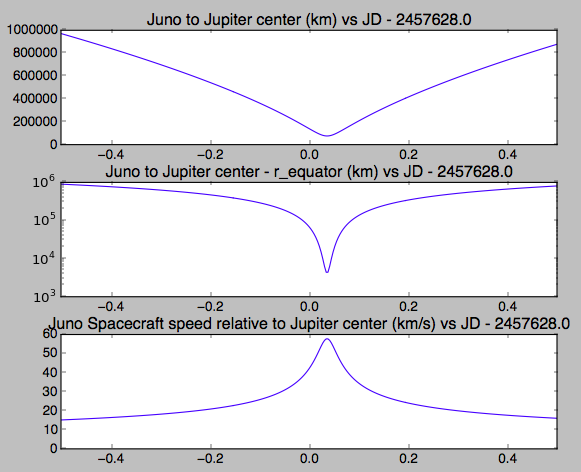I "watched" Juno's flyby of Jupiter using the simulation in the NASA's Eyes app on my laptop, and later saw the good news in this tweet. Now I want to do a "flyby in Python".
Using the setup (shown below) in the Horizons web interface, I can easily download the state vectors of the Juno Spacecraft and Jupiter itself and subtract. This is predicted data of course, not real-time telemetry.
The header in the data file for the Juno spacecraft seems to suggest that the flyby is covered by the most recent calculation, the last entry in the list entitled ref_160226_180221_160226_V0.1. Everything after April 18, 2016 is predicted.
If I would like to see an updated trajectory - which includes measurements taken after this flyby, should I just keep checking back here, or is there somewhere else I can look to see at least notification that a new calculation has been done that is based on more recent data?
SPACECRAFT TRAJECTORY:
From JPL navigation team. Predicts after 2016-Apr-18.0.
Trajectory name Start (CT) Stop (CT)
------------------------------ ----------------- -----------------
rec_110805_111026_120302 2011-Aug-05 17:19 2011 OCT 26 00:00
rec_111026_120308_120726 2011 OCT 26 00:00 2012 MAR 08 12:00
rec_120308_120825_121109 2012 MAR 08 12:00 2012 AUG 25 00:00
rec_120825_130515_130708 2012 AUG 25 00:00 2013 MAY 15 00:00
rec_130515_131005_131031 2013 MAY 15 00:00 2013 OCT 05 12:00
rec_131005_131014_131101_reco 2013 OCT 05 12:00 2013 OCT 14 00:01
rec_131014_131114_140222 2013 OCT 14 00:01 2013 NOV 14 06:00
ref_131114_171017_140311_V0.2 2013 NOV 14 06:00 2015 MAR 26 00:00
ref_150326_180221_150326_V0.1 2015 MAR 26 00:00 2016 FEB 26 00:01
ref_160226_180221_160226_V0.1 2016 FEB 26 00:00 2018 FEB 21 11:40


